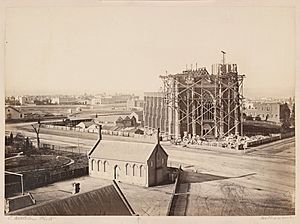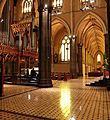St Patrick's Cathedral, Melbourne facts for kids
Quick facts for kids St Patrick's Cathedral |
|
|---|---|
| Cathedral Church and Minor Basilica of Saint Patrick | |

Gothic Revival central tower of St Patrick's Cathedral
|
|
| 37°48′36″S 144°58′34″E / 37.81000°S 144.97611°E | |
| Country | Australia |
| Denomination | Roman Catholic |
| History | |
| Status | Cathedral, minor basilica |
| Dedication | Saint Patrick |
| Dedicated | 1851 |
| Consecrated | 1897 |
| Architecture | |
| Functional status | Active |
| Architect(s) | William Wardell |
| Architectural type | Cathedral |
| Style | Gothic Revival |
| Years built | 1858 – 1939 |
| Specifications | |
| Length | 103.6 metres (340 ft) |
| Width | 56.4 metres (185 ft) |
| Nave width | 25.3 metres (83 ft) |
| Nave height | 28.9 metres (95 ft) |
| Number of spires | 3 |
| Spire height | 105 metres (344 ft) |
| Materials | Bluestone |
| Administration | |
| Parish | St Patrick's |
| Archdiocese | Melbourne |
| Metropolis | Melbourne |
| Province | Melbourne |
The Cathedral Church and Minor Basilica of Saint Patrick, often called St Patrick's Cathedral, is a very important church in Melbourne, Australia. It is the main church for the Roman Catholic Archdiocese of Melbourne. It is also where the archbishop, currently Peter Comensoli, has his official seat.
In 1974, Pope Paul VI gave the cathedral a special title: "minor basilica." This is an honor given to churches that are very important. Later, in 1986, Pope John Paul II visited the cathedral during his trip and spoke to the church leaders there.
The cathedral is built in a traditional way, facing east to west. The main altar is at the eastern end. This design is like a Latin cross when seen from above. It has a long main hall called a nave with smaller aisles on the sides. It also has transepts, which are like the arms of the cross, and a special area called a sanctuary with seven small chapels.
The cathedral was added to the Victorian Heritage Register in 1999. This means it is a very important historical building.
Contents
Where is St Patrick's Cathedral?
The cathedral is located on Eastern Hill in Melbourne. It is surrounded by Albert Street, Gisborne Street, Lansdowne Street, and Cathedral Place. Right across Gisborne Street, you can find St Peter's Church, which is an Anglican church built between 1846 and 1848.
The Story of St Patrick's Cathedral
How it Began
In 1848, a priest named James Alipius Goold became the first bishop of Melbourne. He was the fourth bishop in Australia. He quickly started talking with the government to get land for a church. He wanted five acres on Eastern Hill, where it would look down Bourke Street. On April 1, 1851, just 16 years after Melbourne was founded, the government gave the land to the Roman Catholic Church.
Most Catholic people in Melbourne at that time were from Ireland. So, the cathedral was named after St Patrick, who is the patron saint of Ireland.
Work on the church started in 1851. But many people left to find gold, so not much was built by 1856. Bishop Goold then asked Charles Francis Hansom to design a bigger church. Only one side aisle was built by 1858. After that, Bishop Goold hired a new architect, William Wardell. Wardell had just arrived from England and was known for designing many Catholic churches in London. These churches were built in the Gothic Revival style. He started designing the new cathedral in December 1858.
Building Style and Design
St Patrick's Cathedral is designed in the Gothic style, like the big medieval cathedrals in England from the late 1200s. It uses a specific type called Geometric Decorated Gothic. This style is very detailed, especially in the large window at the western end of the main hall. The eastern part of the church, with its chapels, also follows this English style. William Wardell was a very skilled architect. He also designed the second St Mary's Cathedral, Sydney, which is even bigger than St Patrick's.

Construction Challenges and Completion
The main hall, or nave, was finished within 10 years. Bells were blessed in a big ceremony in 1868. A temporary wall was put up so services could begin. Building such a huge church from bluestone was very expensive. There were long delays because they needed to raise more money. The sanctuary and chapels took even longer to build. A serious economic downturn in Melbourne in 1891 caused more delays.
Finally, under Archbishop Thomas Carr, the cathedral was mostly finished, except for the tall spires. It was officially opened and blessed on November 1, 1897. St Patrick's is considered one of the two largest churches completed in the 19th century worldwide. The other is St Patrick's Cathedral in New York.
Daniel Mannix, who became Archbishop of Melbourne in 1917, cared a lot about the cathedral. Money was raised for the spires starting in 1929. Construction began in the mid-1930s. The spires were built taller than Wardell's original plan and finished in 1939, along with a new front door.
The cathedral is 103.6 metres (340 ft) long and 56.4 metres (185 ft) wide across its transepts. The main hall is 25.3 metres (83 ft) wide and 28.9 metres (95 ft) high. The central spire is 105 metres (344 ft) tall, and the two spires on either side are 61.9 metres (203 ft) high. The bluestone used to build it came from nearby Footscray.
Restoration Work
To celebrate 100 years since its official opening in 1997, the cathedral was closed for all of 1994. It underwent major repair and cleaning work. No new parts were added to the main building. Instead, old parts were carefully fixed. Money for this came from the government, businesses, and people in Melbourne.
The beautiful stained glass windows were bent and cracked. It took a whole year to fix them to look like new. Teams of stonemasons and stained-glass artists used old building methods and materials. These were methods that had been forgotten for a long time, like those used in medieval times. The restoration work from 1992 to 1997 won an award for heritage architecture. One of the gargoyles that was fixed was even shaped like the Premier of Victoria at the time, Jeff Kennett.
Music at the Cathedral
Cathedral Choir
Music has been a part of St Patrick's since 1858. The current cathedral choir started in 1939. This happened when the Vienna Mozart Boys Choir was stuck in Australia because of World War II. The National Museum of Australia has many items from the choir from this time. Today, St Patrick's choir has between 50 and 60 members. They are all students from St Kevin's College who receive scholarships from the church. The choir has made many recordings over the years.
Cathedral Singers
The St Patrick's Cathedral Singers group was formed in 1996. They help with the music at the cathedral. Since 2015, Christopher Mason has been their director. The singers perform every Sunday at the 6:30 pm Mass. To join, students must try out, and some scholarships are available.
Pipe Organs
The cathedral's first pipe organ was built in the late 1870s. The current organ was built in 1962–64 and includes many parts from the original. It is located in the west gallery of the cathedral. This large organ has 81 different sounds, called stops. These are played using four manuals (keyboards) and pedals. Some parts of the organ date back to 1880 or 1896, when it was made bigger. The organ was repaired in 1996–97 for the cathedral's 100th anniversary. Besides being used for church services, the organ is sometimes used for concerts and recordings.
Bells of the Cathedral
The bells of the cathedral were bought by Bishop Goold when he visited Europe in 1851–1852. He bought a set of eight bells for about £500. They arrived in Australia in 1853. This set of eight bells is tuned to the note F. The largest bell weighs about 12 tons, and the smallest weighs about 4 tons. All the bells were made by John Murphy in Dublin in 1852.
The bells were first hung in a low frame in 1868. About 5,000 people attended the blessing ceremony. The largest bell has Bishop Goold's coat of arms on it. The bells were later moved to the south-eastern tower.
The bell ringers at St Patrick's started the tradition of ringing in the New Year in 1871. By the 1880s, St Patrick's Cathedral was a leading place for change ringing in Australia. The bells were rung for the funeral service of Pope Pius X in 1914. By 1959, the belfry (the part of the tower where the bells are) was in bad shape, and the bells could not be rung.
The bells were silent until 1988. They were sent to England for restoration as a major project for Australia's Bicentennial. When they returned, a ninth bell, an Angelus bell, was added. An electronic system was also installed so the bells could be chimed automatically. This system can also copy how the bells would sound if rung by hand. The parts that hold the bells, called headstocks, had to be replaced again just ten years later. The bell ringers are part of The Australian and New Zealand Association of Bellringers.
These bells are special because they were not tuned when they were cast. They also ring counter-clockwise instead of clockwise. They are thought to be the only set of eight bells made by Murphy that are still used today.
Photo gallery
-
Archbishop Daniel Mannix (1863-1964) bronze statue
-
Irish Nationalist leader Daniel O'Connell statue
-
St Catherine of Siena (1347-1380) statue
-
St Francis of Assisi (1181-1226) statue
-
River from the throne of God and of the Lamb
See also
 In Spanish: Catedral de San Patricio (Melbourne) para niños
In Spanish: Catedral de San Patricio (Melbourne) para niños
















